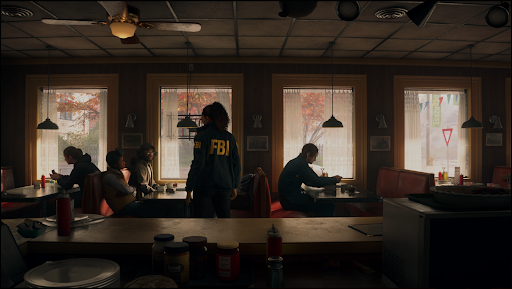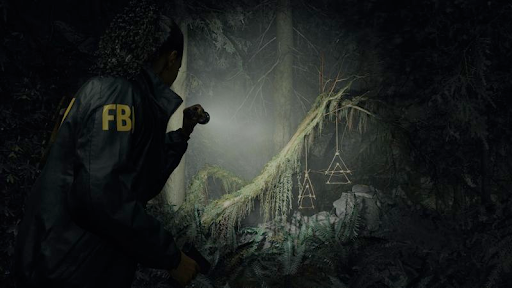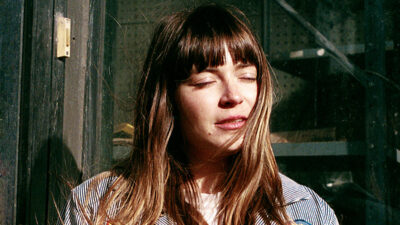Thanks for clicking into our end of the year coverage! Merry-Go-Round Magazine is an independent culture site funded by people like you! If you’re enjoying our End of 2023 Coverage, consider becoming a member of our Patreon, or even donating to our operation here!
By all accounts, ALAN WAKE II wasn’t supposed to happen. Remedy Entertainment, the game’s developer, said as much when it revealed one of its original prototypes for the game to Polygon in 2015. Microsoft, the publisher of 2010’s ALAN WAKE, was more interested in Remedy creating something new for the upcoming Xbox One console than any ideas for a sequel. “From the creative perspective, it would be awesome if we could just create cool stuff and not worry about minor details like money,” Remedy’s Sam Lake explained when the Xbox One-exclusive QUANTUM BREAK was ultimately announced rather than an ALAN WAKE II. “But we all know that’s not the case.”
QUANTUM BREAK was released in 2016 as a third-person shooter with a companion, Syfy-quality procedural TV show. The game was okay, but Remedy wouldn’t truly win the masses over again until 2019’s CONTROL. And now, 13 years later, with the critical success of CONTROL behind it and a hands-off publishing deal from Epic, we somehow got ALAN WAKE II. A game that not only picks up the pieces of the original TWIN-PEAKS-by-way-of-Stephen-King vibes of its progenitor, but manages to incorporate everything Remedy learned about making games and the studio’s omnivorous hunger for media of all kinds. A riff on TRUE DETECTIVE as much as TWIN PEAKS: THE RETURN, with ALAN WAKE II, Remedy has found a way to hold a bunch of disparate mediums in a single narrative, carving out a more interesting kind of AA storytelling in the process.
ALAN WAKE II follows Saga Anderson, an FBI agent who, with her partner Alex Casey (physically performed by Sam Lake and voiced by Matthew Paretta), arrives in Bright Falls to investigate a series of murders around nearby Cauldron Lake. Those murders end up being the work of a cult, who, as it turns out, might be inspired by the works of Alan Wake. Add in some supernatural fuckery and the sudden reappearance of the man himself, and you have the recipe for a solid video game.
At first blush the sequel plays the hits. Like THE RETURN, our original hero is missing, trapped in a literal Dark Place. New main characters like Saga Anderson are introduced to give the narrative momentum. Older characters like the geriatric band The Old Gods of Asgard are recontextualized. The Pacific Northwest town of Bright Falls is bigger, to match the slightly tweaked and expanded thematic concerns. A song plays at the end of every chapter, just like the Roadhouse performances in David Lynch’s return to television. And most important to ALAN WAKE II, and eventually, TWIN PEAKS: THE RETURN, there’s an acknowledgment of the fallibility of the main character we’re familiar with. They are more flawed than we knew, even if we weren’t able to see it (or the creators didn’t realize it) at the time.

Bright Falls also has a diner full of kooky characters
A phrase is repeated throughout Alan’s adventure in the underworld: “It’s not a loop, it’s a spiral.” In context, that’s a reference to the elliptical nature of Alan’s side of the story: how he seems to keep failing over and over again, but is actually progressing deeper. But it’s also about ALAN WAKE II itself. Games are built on loops—patterns of interaction that convey a certain feeling and achieve a certain narrative or mechanical effect. They can be repeated over and over again, but they do take you to a certain place. Things that seem repetitive actually do something.
You travel through the spiral via new mechanical layers. The more action-focused gameplay of the first ALAN WAKE has been converted to something a little more deliberate, annoying, survival horror-inspired, and open-world. ALAN WAKE II even includes the inventory management of a RESIDENT EVIL game. There’s also two new meta-locations that directly fuse mechanics with narrative. For Saga, it’s “The Mind Place,” a sort of mind palace cabin where she can puzzle through her cases, red-string-on-cork-board-style, upgrade weapons, and “profile” subjects to create new leads to follow. For Alan, it’s “The Writer’s Room,” a recreation of his attic writing room from the previous game with a storyboard that can be arranged to rewrite environments in the Dark Place to solve puzzles. You can enter these places at will, and because of the bifurcated structure of the game, play through the dueling protagonists’ stories in any order you choose.
Throughout, live-action footage is layered over the game. Jump scares occurin the form of photographs and music cues, ads shot with real actors, and overlapping images when Alan’s side of the game bleeds over into Saga’s, or a particular saucy piece of scene-setting needs to be delivered via the silhouette of Alan Wake’s potboiled detective Alex Casey (yes,there’s an in-universe fictional Alex Casey too). The game is a mess of different mediums in its composition and content, but with a method to its madness. There’s a suggestion in ALAN WAKE II that the artificial is more real than the real. Emphasis on “more.” It’s not necessarily that reality is fake, but that it’s been overburdened with stories, made-up things, cast-off ideas, and directionless feelings. Feedback loops that spiral in darker and darker directions.
The game explores this in several ways, to varying degrees of success. The cult Saga investigates has all the markings of a post-Qanon white supremecist movement, with rituals, alternate histories, and a willingness to take action towards destructive ends. They’ve been convinced of a certain story of why Cauldron Lake and Bright Falls are “off,” and they’re playing a part in a narrative to make it stop. Saga herself is caught up in a story, too—the game ALAN WAKE II itself. She’s written to be the hero of the story against her will by Alan, with more than a few consequences for her personal life, and fights against it for most of the game, literally and figuratively. It helps that she’s everything Alan isn’t. A black woman who fought for her position, a mother, someone who in general tries to have empathy and understanding for other people, and someone who has a strong enough sense of self to know her own worth. With Saga’s story, ALAN WAKE II suggests that creativity is hungry. It needs to eat, chew on, and digest real things so it can turn out something more than real. Saga is just one casualty of that.

Saga’s interactions with The Cult of the Tree is the closest the game gets to addressing race
Games too, are hungry. While there’s a growing acceptance that there’s nothing that makes the medium of video games unique (other arts can be interactive, digital, highly expensive to make, and generate empathy), it’s fair to say that as of late, games have become more upfront about how they recycle and remix other media. It’s obvious in retrospect that the creators of THE LAST OF US would be interested in adapting the game into a TV show, because it’s often structured like a prestige one. The new GOD OF WAR had no cuts, because that’s long been a cool way to sell action in a film. GHOST OF TSUSHIMA had a “Kurosawa Mode,” etc. These choices are often viewed from the angle of the medium’s immaturity. “The people making the biggest games in the world want them to be celebrated like movies so badly that they started making them look like them.” There’s a grain of truth to that. But games, like all interdisciplinary art forms, naturally draw people with a diverse media diet. If not at the top, then at other points along the production line. That was bound to express itself in some way, at some exorbitant dollar amount.
Where ALAN WAKE II really brings everything into focus for me is the decidedly video game-y Mind Place. The repetitive act of laying out and connecting cards. Solving puzzles that aren’t really puzzles and receiving a little morsel of narrative or characterization in the process. I’m not sure how intentional it was, but the mechanics of the Mind Place wear out their welcome early. It’s not that the parts of the story you get there are boring, far from it. It’s that laying out flash cards with a controller is annoying, to the point of wanting to avoid it entirely. By the end of the game, Saga is at her wits’ end. The negative effects of Alan’s meddling with reality may well be permanent and the Mind Place, whether by supernatural influence or her own self doubt, is actively fighting against her. Object descriptions get rewritten, formerly positive memories get a darker hue, and the corkboard you’ve spent so much goddamn time organizing begins to be filled by endless notecards of depressed and demeaning internal monologue. It’s overwhelming… until Saga decides that it’s not true. This is her mind, and she knows who she is.
ALAN WAKE II is, at times, frustrating to play and a little undercooked when it comes to any identity outside of Alan Wake’s. But, its decoupage of game mechanics, movies, and TV shows, if you let it spiral long enough, is hard to ignore or forget. Like Saga, it knows what it is, and what that’s worth.
















Comments